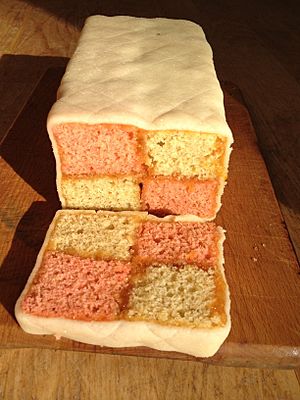Battenberg cake facts for kids
The Battenberg cake is a yummy and colorful sponge cake. It's easy to spot because it's long and has a square shape. This special cake is covered in a sweet almond paste called marzipan.
When you slice into a Battenberg cake, you'll see a cool checkerboard pattern. It has four smaller squares, two pink and two yellow, arranged alternately. To make this pattern, bakers dye half of the cake batter pink and the other half yellow. After baking, each colored cake is cut into two long, even rectangular pieces. These pieces are then carefully joined together with apricot jam to form one cake.
Contents
How it's made
Making a Battenberg cake is a bit like building with edible blocks! First, a light sponge cake batter is divided. Half of it is colored pink, and the other half is left yellow. Each colored batter is baked separately to create two different sponge cakes.
Once cooled, each cake is cut into two long, straight pieces. Then, these four pieces are put together like a puzzle. A layer of sweet apricot jam is spread between them to stick them together. This creates the famous pink and yellow checkerboard design. Finally, the whole cake is wrapped in a thin layer of marzipan, which is a sweet paste made from ground almonds and sugar.
Different flavors
While apricot jam is traditional, some people like to use other fillings. You might find Battenberg cakes with lemon curd or raspberry jam instead. Sometimes, the sponge cake itself can have a coconut flavor, adding another delicious twist to this classic treat.
History of the Battenberg Cake
The Battenberg cake is believed to have been created to celebrate a special royal event.
A Royal Wedding Cake
The cake was likely named in honor of the marriage of Princess Victoria of Hesse and by Rhine to Prince Louis of Battenberg. This royal wedding took place in 1884. Princess Victoria was a granddaughter of Queen Victoria, a famous British queen.
The four squares inside the cake are said to represent the four Battenberg princes: Louis, Alexander, Henry, and Francis Joseph. This makes the cake a sweet way to remember a historical family connection.
Images for kids
See also
 In Spanish: Battenberg cake para niños
In Spanish: Battenberg cake para niños



